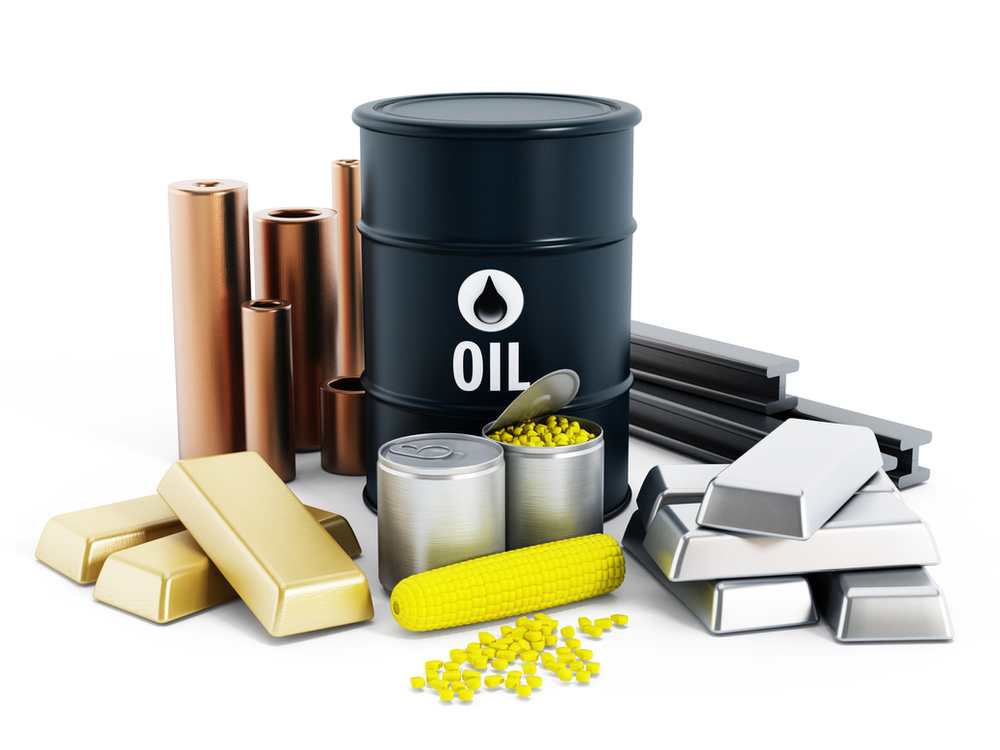Clever investors are getting in early and hoping the journey will carry on for a long while.
Most people don’t give commodities a second guess. I would even go as far as to state that most Canadian investors neither own commodities nor realize it if they do. It is far more common that any commodities are in paper assets as part of a fund they own in a registered holding or a stock. Well, here is something to enlighten those seeking more options.
Commodities price gains/losses year-to-date:

As you can see, there is a storm of higher commodities prices which have hit the world economies like a tonne of bricks. The real threat of inflation has been felt this year in everything from building supplies to gasoline and food items to clothing. Yet, I have highlighted two commodities on that chart for obvious reasons.
Both Gold and Silver remain in the negative gains category. If you reread the title, you may also note that there are precious few commodities left that will represent excellent value as we approach what I think will be a possible commodities supercycle.
As we head through the 3rd quarter of 2021, the world’s largest mining companies are starting to report their results, and several have published trading updates that show beyond any doubt that commodity markets are booming. But does it mean the world economies are healthy? Or is this a case of cheap money flooding into the major metropolises of the world and creating false hope? Perhaps we can determine this by asking whether or not this is a blip or a true commodities supercycle?
Commodity supercycle?
Commodities have been booming lately. Copper is 95% higher than in March 2020 and 50% above pre-Covid-19 levels. It has been reaching levels last seen in 2011.
Oil is back at $70, at levels that were not supposed to be possible in a world phasing out fossil fuels, and with technological advances in oil and gas extraction that were supposed to increase supply and keep prices low.
Even thermal coal, which many market participants declared dead not long ago, nearly tripled in price since last year and has made fresh 10-year highs recently.
And for our readers, and in particular, those of you following along since the first decade of the 2000s when I used to publish the “Precious Metals Advisor,” this is the second roundtrip commodity bull market in two decades.
Similar to 2007, there is current debate around the likelihood of a commodity supercycle – a time when commodity prices trade above their long-term trends for an extended period.
In 2007, the argument was that unbridled Chinese demand had given rise to a supercycle and, indeed, commodity prices were high in the following years. Today, arguments favouring a supercycle tend to focus on the lack of new supply to meet the future demands of decarbonization and infrastructure expansion.
The forces driving commodity markets are complicated, but have provided a brief overview as economies emerging from Covid-19 lockdowns, coupled with relatively tight supply, have been significant factors driving markets.
Cycles
Commodity markets tend to move in pronounced cycles. Despite sporadic surges in demand, such as we have witnessed in China this century and are likely to see as part of the green revolution in coming years, it often takes supply a long time to respond.
To demonstrate, a new mine operation starting from scratch will likely take more than ten or more years to develop a new large-scale project.
If we consider the last big cycle in response to China’s insatiable demand for commodities, capital expenditure in the mining sector increased considerably from 2004 to 2012 – which resulted in metals flooding the market from 2012 to 2015 and pushed prices lower. Many miners had near-death experiences between 2012 to 2015. Our metals of gold, silver, palladium and platinum here at Delta were somewhat stagnant and less favoured as risk-off environments grew worldwide during 2012-2015. Importantly, this has had a pronounced impact on subsequent investor psychology.
The mantra from the institutional shareholder base has been prioritizing restoring balance sheets and only after that focusing on capital returns to shareholders. Following this mantra has contributed to limiting new supply of raw metals and materials and gold and silver.
Following this mantra will also likely prolong the current price trend, which bodes very well for those desiring assets such as gold and silver.
(Both gold and silver have remained relatively good buying opportunities, well below their expected yearly cumulative averages, which remain approximately 9-10% in each metal stemming from 2004.)
Astute investors
Are Canadian investors investing in resource companies and benefiting from the boom?
Fortunately for them, the Canadian investing firms have been big on mining and commodity stocks for an eternity, so it is likely that, yes, many of you already hold paper investments in commodities and, as stated above, probably don’t even realize it.
It is also important not to forget that the Canadian economy’s dependence on the fortunes of the commodities means that the trade surplus and strength in the Canadian dollar up to June should remind us of the windfall resulting from surging commodity prices, including precious metals. (Many have probably now heard of the new “Canadian Gold Rush”)
However, a feature of the current investment environment is that global portfolios are heavily exposed to the winners of the past – passive, growth stocks and the US marketplace – and the weightings of sectors like materials, metals and energy in indices are still reasonably low.
Despite the run-up in commodity prices and recent price performance, we still believe at Delta that gold and silver will play lots of catch up with many stocks, and both metals can be acquired at attractive valuations. While both metals had a fantastic 2020, they have yet to take off in 2021, making them very attractive to astute investors.
Compelling
Gold and silver can return a lot of cash to owners in very short periods and can serve as cheap hedges against future inflation, making them an exciting part of a balanced portfolio in times of inflationary threats, such as right now.
While we believe there are many excellent companies out there for investors to own paper assets, our view has been that their high valuations overall tend not to compensate investors for the risk taken at this time.
It makes something like very low priced physical silver bars a desirable alternative to adding diversification to one’s wealth strategy.
Considering the weighting of the overall marketplace at the moment, there is not very much contrarian thinking being put to good use as we continue to witness a lot of very overweighted buying in sectors that have already passed their primes.
The situation in the US market is even more extreme, with Apple at 6.3% of the S&P 500 being more prominent than materials and energy combined .
Change in sentiment?
Is there one? Well, that depends on who you ask. We believe that although not all the hallmark signs have arrived to support the notion of a significant supercycle, we are early to something already happening. Still, early in a sense, we are incredibly astute.
It could also be because, like on our radio show this week, Hard Money, we may well be starting to experience a brand new type of supercycle, not dependent on hydrocarbons. A supercycle involving a once-in-a-lifetime transition to a nonhydrocarbon society. This is huge!
Outside of a supercycle, I would still hold gold and silver and do my wealth strategy. Our position in suggesting gold and silver as part of a wealth strategy is biased, but for a good reason. If this becomes a supercycle like suggested, we are in for a tremendous journey, and those astute enough to be balanced and leave some room for hard assets may be big winners!
Yours to the penny,
Darren V. Long






